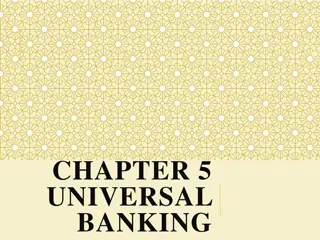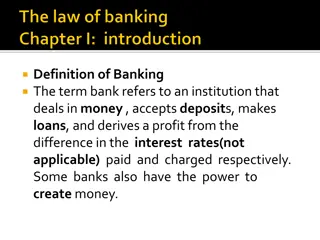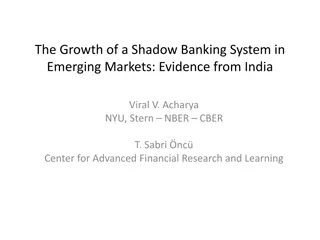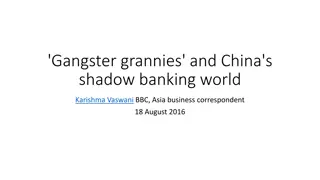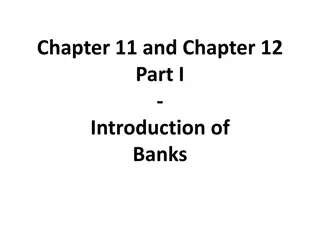Understanding the Banking Sector Fundamentals
Banks play a vital role in the economy by accepting deposits and providing loans, aiding in capital formation and accumulation. The word "bank" originates from the French term for a bench. The Banking Regulation Act of 1949 defines banking activities. Banks deal with money deposits, credit, and commercial transactions, offering services such as accepting deposits, lending money, and safeguarding valuables. They operate based on principles like liquidity, solvency, profitability, and efficiency. Banks borrow from the public and charge interest, with minimal borrowing procedures.
Download Presentation

Please find below an Image/Link to download the presentation.
The content on the website is provided AS IS for your information and personal use only. It may not be sold, licensed, or shared on other websites without obtaining consent from the author. Download presentation by click this link. If you encounter any issues during the download, it is possible that the publisher has removed the file from their server.
E N D
Presentation Transcript
Introduction to banking Introduction to banking sector sector
Banks are institutions that accepts various types of deposits and use these funds for granting loans. It helps in capital formation and capital accumulation. Banks are reservoirs of resources. Banks are at the heart of the financial system.
The word bank has been derived from the French word Banco /Bancus /Banc/Banque which means a bench . In India, Bank of Hindustan was the earliest bank started under European directions. In England, the bankers of Lombardy had taken the initiative to start modern banking along with their trading activities.
The Banking Regulation Act,1949 (Sec. 5(B)) defines the term Banking Company as a company which transact the business of banking in India , and the term Banking has been defined as Accepting for the purpose of lending and investment of deposits of money from the public, repayable on demand, order or otherwise and withdrawable by cheque, draft or order or otherwise.
Dealing in Money Deposits must be Withdrawable Dealing with Credit Middle Man Commercial in Nature Risk Transformation Size Transformation Nature of Agent
Accepting Deposits From Public Lending money to public Transferring money from one place to another Doing Government Business transactions Keeping valuables in safe custody Acting as trustees
Principle of Liquidity Principle of Solvency Principle of Profitability Principle of Loan & Investment Principle of Saving Principle of Service Principle of Secrecy Principle of Efficiency Other Principles
Lend money from own saving. Frequently combine banking with trading activity. Usually charge very high rate of interest. Procedure for borrowing are minimal Usually money has to be returned after a fixed period. No restrictions as to mode of demand or time and place. Lending from deposits received from general public. Trading activity is prohibited. Rate of interest are comparatively lower. Paper work, formalities are more. Money has to be returned on demand. Demand can be made only through cheques, drafts, order, etc. during working hours in bank premises. 1) 1) 2) 2) 3) 3) 4) 4) 5) 5) 6) 6)
Formation Capital Operations Opening of branches
Public sector Bank At least 51% ownership with the government. They have old set up so capital assets are more. Branches are more including those in rural areas. Number of employees is much more,& they are organized in Trade Unions. Fund income is more as concentration is more on loans & advances. Less technology savvy. NPAs are quite higher. Government control is more Majority shareholding lies with the general public. Set up with lower capital base. Branches are less including those in rural areas. Less number of personnel & unions do not pose a problem. Fee income is more as they earn commission from loan syndication. Use state-of-the-art technology. NPAs are much lower. More freedom to operate.
Commercial Banks Co-operative Banks These banks function on business line i.e. to earn profit. Established as joint stock company or registered as public corporation under separate Act of Parliament. Are organized on unitary basis. Branch network is spread far and wide within and out of the country. They are governed by all sections of the Banking Regulation act,1949. The concept of cooperatives banks are no profit, no loss .it works on principles of cooperation, self-help & mutual help. Are established under the cooperation Societies Acts of different states. Have a three-tier set-up Area of the operation is restricted to local/district state. Only some sections of the Act are applicable to them.
It is a joint stock company incorporated in India. Area of operation extends to whole of India. Income is more from core banking operation i.e. lending. Main strength lies in their huge number of branches & the number of employees. Obtaining a license from RBI is comparatively easier Focus is more on middle and lower income groups. Operations are mostly local level. It is the branch of a joint stock company incorporated outside India. Operations are concentrated in metro and tier 1 cities. Income is more fee based and new products like credit card, mutual fund , etc. Main strength lies in their technology & vast capital resources as well as their networking. It is more difficult to obtain a license from RBI. Focus is more on high income groups, large corporates and MNCs. Operations are international level.
Globally financial authorities have created room for the participation of non-bank institutions in enabling payments. Pre-paid Instrument Providers (PPIs) :- It allows customer to store or Pay for goods & services from digital wallets.it accept maximum amount of Rs. 50,000/- & it required to maintain ESCROW account with a scheduled commercial bank. E.g. of PPI is PayTm .
Objectives Eligible Promoters Scope of activities Deployment of funds Capital requirement Promoter s contribution Foreign shareholding Application & RBI decision
Structure & management Objectives 1. To provide credit & other facilities to small & marginal farmer 2. To encourage rural entrepreneurship. 3. To increase employment opportunities in the rural areas; 4. To provide loan for backward class public.
It is deemed to be a co-operative society for the purpose of Income Tax Act, 1961. Area of operation is limited to a specified region. It grant loans to the small & marginal farmers, agricultural labourers, This is a sponsored bank. The RRB charges interest rates as adopted by the co-operative societies in the state.
Providing short term crop loans. Granting loans to co-operative societies for agricultural purposes. Extending term loans for agricultural activities. Implementation of different rate of interest Setting up & maintenance of godowns & warehouse. Reducing the dependency of weaker section









